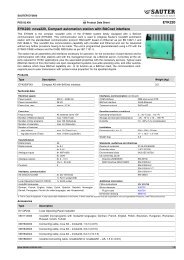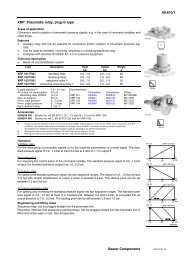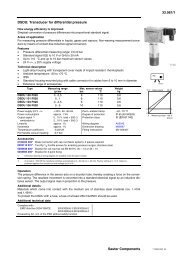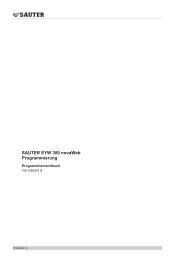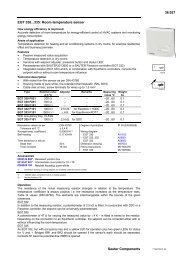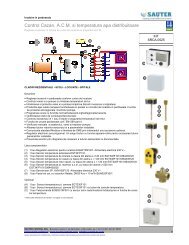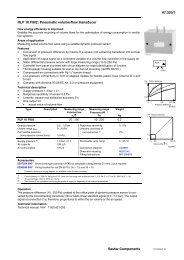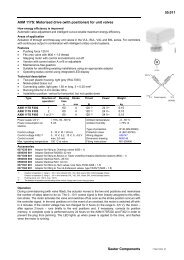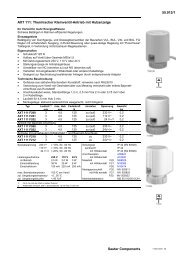DSD: Differential-pressure switch - sauter-controls.com sauter ...
DSD: Differential-pressure switch - sauter-controls.com sauter ...
DSD: Differential-pressure switch - sauter-controls.com sauter ...
- No tags were found...
You also want an ePaper? Increase the reach of your titles
YUMPU automatically turns print PDFs into web optimized ePapers that Google loves.
23.402/1<strong>DSD</strong>: <strong>Differential</strong>-<strong>pressure</strong> <strong>switch</strong>How energy efficiency is improvedDemand-led controlling and monitoring, without auxiliary energy.Areas of applicationFor controlling and monitoring <strong>pressure</strong>s in liquids, gases and vapours, as well as for monitoring theflow of heating pumps. Especially suitable for equipment that is subject to vibrations.Features• Pressure range: 0.2 to 16 bar• Contact rating: 4 mA, 5 V to 10 A, 250 V• Up to 110 °C media temperature• Gold-plated silver contacts• Adjustable <strong>switch</strong>ing difference• Sealable• Mechanical service life: > 1x 106 <strong>switch</strong>ing cyclesTechnical description• Light-alloy housing with transparent cover made of impact-resistant thermoplastic• Ambient temperature: -20 to +70 °C• IP 65• Standard housing-mounted plug with cable connector for cables of 6 to 10 mm in diameterType Range Switching Max. sensor values Weightdifferencebar bar bar °C kg<strong>Differential</strong>-<strong>pressure</strong> <strong>switch</strong> with variable <strong>switch</strong>ing difference<strong>DSD</strong> 137 F001 0,2...1,0 0,20...1,4 6 110 0,63<strong>DSD</strong> 140 F001 0,4...2,5 0,40...1,6 10 110 0,63<strong>DSD</strong> 143 F001 0,5...6,0 0,45...2,2 12 110 0,63<strong>DSD</strong> 152 F001 1,0...16 0,60...3,4 25 110 0,63<strong>Differential</strong>-<strong>pressure</strong> <strong>switch</strong> with fixed, small <strong>switch</strong>ing difference<strong>DSD</strong> 134 F101 0,05...0,4 0,04 6 110 0,63XsdPD3 2Y033071B06966PDXsContact rating:- Ambient temperature –20...70 °Cas silver contacts 1) 10(3) A, 250 V~ Degree of protection IP 65 (EN 60529)50 W, 250 V= Protection class I (IEC 60730)minimum100 mA, 24 Vas gold-plated contacts 2) 160 mA, 50 V Wiring diagram A01499minimum 4 mA, 5 V Dimension drawing M06967Permissible vacuum loading –0,7 bar Fitting instructions MV 505424<strong>DSD</strong> 152–1,0 barAccessories0190403 005* Brass connector with cap nut (Serto system), 2 pieces required0259984 000* Bracket for 3-point fixing0292110 001* Two throttle screws, Rp 1 /8, for arresting <strong>pressure</strong> surges; stainless steel.0296936 000* Fixing bracket for top-hat rails EN 60715, 35 × 7,5 or 35 × 15*) Dimension drawing or wiring diagram are available under the same number1) If under inductive load, take RC circuit into account2) If the contacts are loaded with more than 160 mA, 50 V, the gold plating suffers irreparable damage.They then lose the properties of gold contacts, and operate thenceforth as silver contactsOperationWhen the <strong>pressure</strong> falls below the lower <strong>switch</strong>ing point (variable setpoint XS), the contacts changeover from 1-3 to 1-2. When the <strong>pressure</strong> rises by the <strong>switch</strong>ing difference XSd above the lower <strong>switch</strong>ingpoint, the contacts change from 1-2 to 1-3.The <strong>switch</strong>ing difference can be set externally using a grub screw: one turn changes the <strong>switch</strong>ingdifference by approx. 20 % of its whole range.Sauter Components7123402003 04
23.402/2 <strong>DSD</strong>Additional informationMaterials that <strong>com</strong>e into contact with the medium are of stainless steel (material nos. 1.4104, 1.4435, 1.4541).Additional technical detailsReproducibility of X s± 2% of the rangeInfluence coefficient on cos ϕ = 1:<strong>switch</strong>ing difference 2) 0,017 10 A, 250,000 <strong>switch</strong>ing operationsRadio suppressed as per EN 55014 5 A, 400,000 <strong>switch</strong>ing operations2 A, approx. 10 6 <strong>switch</strong>ing operationscos ϕ = 0.6:3 A, 400,000 <strong>switch</strong>ing operationsComplies with:- cos ϕ = 0.3: 1)Directive 2006/95/EC EN 60730-1/ EN 60730-2-6 3 A, 250,000 <strong>switch</strong>ing operationsEMC directive 2004/108/EC EN 61000-6-1/ EN 61000-6-2 2 A, 400,000 <strong>switch</strong>ing operationsEN 61000-6-3/ EN 61000-6-41 A, 700,000 <strong>switch</strong>ing operationsNot covered by the PED directive Art. 1.3.6 of the PED Mechanical life: > 1 × 10 6 <strong>switch</strong>ing operations1) cos ϕ < 0.3: substantial reduction in life expectancy; with RC circuitry, life expectancy is as forcos ϕ > 0.3 (see also technical notes).2) see technical notesTechnical notesRC circuit under inductive loadFor the optimum RC circuitry, refer to the specifications supplied by the manufacturers of the relays, contactorsetc. If these are not available, the following rule of thumb can be applied:-• Capacitance of the RC circuit (μF) is equal to or greater than the operating current (A).• Resistance of the RC circuit (Ω) is approx. equal to the resistance of the coil (Ω).B03772Influence coefficient on <strong>switch</strong>ing differenceThe <strong>switch</strong>ing difference is slightly dependent on the setpoint. The <strong>switch</strong>ing differences stated in the PDSsheet are typical values at the start of the range. The influence of the setpoint on the <strong>switch</strong>ing difference isworked out thus: (setpoint X S - start of range) × influence coefficient.Wiring diagramDimension drawing451 2 3PA01499a67 1080 50<strong>DSD</strong>Pg112561Ø4,5Ø4,5Rp1/8481664595 10628Ø4567M06967Sauter Components7123402003 04
<strong>DSD</strong> 23.402/3Accessories2969362554,5259984204,51,5M3X6292110 G1/824144,510181330324025371213180,5M001669583,5M00654190403/00533R1/810Ø6M07633sw14R1/8M09870Sauter ComponentsPrinted in SwitzerlandRight of amendment reservedN.B.: A <strong>com</strong>ma between cardinalnumbers denotes a decimal point© Fr. Sauter AG, CH-4016 Basle7123402003 04



